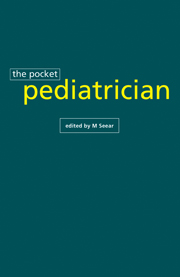Book contents
- Frontmatter
- Contents
- Analytical contents list
- Preface
- 1 Cardiology
- 2 Death and dying
- 3 Emergencies
- 4 Endocrinology
- 5 Fluids and electrolytes
- 6 Gastroenterology
- 7 General surgery
- 8 Health care ethics
- 9 Hematology
- 10 Infectious diseases
- 11 Intensive care and continuous infusion drugs
- 12 Medical genetics
- 13 Neonatology and neonatal drug dosage guidelines
- 14 Neurology
- 15 Nutrition
- 16 Oncology
- 17 Pediatric transport
- 18 Pharmacology and drug dosage guidelines
- 19 Renal
- 20 Resident fellow training
- 21 Respirology
- 22 Rheumatology
- 23 Transfusion medicine
- 24 Appendix
- Index
13 - Neonatology and neonatal drug dosage guidelines
Published online by Cambridge University Press: 01 February 2010
- Frontmatter
- Contents
- Analytical contents list
- Preface
- 1 Cardiology
- 2 Death and dying
- 3 Emergencies
- 4 Endocrinology
- 5 Fluids and electrolytes
- 6 Gastroenterology
- 7 General surgery
- 8 Health care ethics
- 9 Hematology
- 10 Infectious diseases
- 11 Intensive care and continuous infusion drugs
- 12 Medical genetics
- 13 Neonatology and neonatal drug dosage guidelines
- 14 Neurology
- 15 Nutrition
- 16 Oncology
- 17 Pediatric transport
- 18 Pharmacology and drug dosage guidelines
- 19 Renal
- 20 Resident fellow training
- 21 Respirology
- 22 Rheumatology
- 23 Transfusion medicine
- 24 Appendix
- Index
Summary
DELIVERY ROOM RESUSCITATION
Labor, delivery and the first minutes of life carry a high risk for asphyxia in the newborn. Anticipation and prompt skillful intervention can prevent the sequelae of asphyxia, minimizing neonatal morbidity and mortality.
The goals of resuscitation are to:
Maintain body temperature within the normal range.
Establish adequate respiratory function.
Intervene early and prevent complications.
A minimum of two persons skilled in neonatal resuscitation should be immediately available for every birth. Personnel should seek periodic theoretical and practical training in this area.
The delivery room environment
Thermoregulation is an immediate priority in managing any newborn. The delivery room area should be maintained draft free and at a temperature between 22 °C and 26 °C.
This recommendation also applies to an Operating Room set up for a cesarean section.
The level of lighting should be regulated. Low levels of lighting may be requested by the parents of well babies but should not affect the capacity of staff to observe the baby's color.
The noise levels should be kept low.
All equipment needed for neonatal resuscitation, including a wall clock with second hand, should be available, easily accessible and in good working order.
Separate oxygen, air and suction outlets should be available for both mother and neonate.
Equipment list
Overhead warmer: turn the warmer on prior to delivery. Ensure that a skin probe is available and the temperature control is set at 37 °C in automatic mode. Check alarm function.
Oxygen source: verify the oxygen source. If a blender is available, set it to provide 100% O2.
- Type
- Chapter
- Information
- The Pocket PediatricianThe BC Children's Hospital Manual, pp. 267 - 352Publisher: Cambridge University PressPrint publication year: 1996



